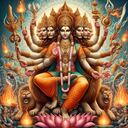Types of Yagya is an article depicting the categories of Yagya or Havan. Yagya has been a Vedic tradition. The divine Agni, the god of fire and the messenger of gods – is deployed in a Yajna, and mantras are chanted.
The Yagya is performed to invoke the deities by ahutis with certain ‘samagri’ and final ahutis is done with samarpan.
What is a Yagya?
It is the performance of a religious duty involving Agni, the sacrificial fire, with the chanting of mantras. The word itself is derived from the root “Yaj” meaning “to worship”, to evince devotion.
The performance of yajna is to please Paramatman (god) and various duties. Yagya is also called ‘Yajna’. Yajna literally means “sacrifice, devotion, worship, offering”, and refers in Hinduism to any ritual done in front of a sacred fire, often with mantras.
What is the purpose of Yagya?
The Vedic sacrifices have a threefold purpose.
- The first is to earn the blessings of the deities so that we as well as all other creatures may be happy in this world.
- The second is to ensure that, after our death, we will happily live in the world of the celestials.
- The third purpose is the most important and it is achieved by performing sacrifices, as taught by the Gita, without any expectation of reward. Here we desire neither happiness in this world nor residence in paradise. We perform sacrifices only because it is our duty to invoke the blessings of the gods for the welfare of the world.
Who can perform the Yagya?
Any sadhak, pundit, or any other person can perform the Yagya. The Yagya can also be done to ‘sponsor’ the Yagya to accomplish certain desires.
What are the types of Yagya?
There are more than 500 hundred types of Yagya mentioned in the Vedas & Shastras. Some of the popular Yagya are:
- Maha Ganapathy Yagya: This Yagya is performed to get the blessings of Lord Ganesh; it is performed at the beginning of all Hindu ceremonies and new ventures. Lord Ganesh is the god for success and wisdom. He will give trouble to those who ignore him. Lord Ganpati is always remembered in every new endeavor, whether it is secular or religious. Maha Ganapathy Yagya involves invoking the Lord Ganpati with various hymns and rituals and then chanting powerful or desired mantras with aahutis.
- Sudarshana Yagya: It is performed to get rid of evil spirits and troubles from enemies. This is a very powerful Yagya and helps eradicate the negative energies around the ‘Yogyakarta’ or sponsor of the Yagya. Sometimes Sudarsana Yagya is performed to get rid of a particular enemy or bunch of enemies.
- Navagraha Yagya: This kind of Yagya is performed in every auspicious work to be done in life. It is performed to pacify the Nine Planets and lessen the malefic effects of the planets. This Yagya is also performed in all the new buildings and new houses and before starting any new adventure.
- Ayush Yagya: This is performed on every birthday of a family member for a healthy and long life. The first birth anniversary of every child is celebrated with Ayush Homam and a lot of people are fed on that day. is also performed in case of poor health and chronic diseases of the sponsor.
- Kushmanda Yagya: This home is a Prayaschitha Homa performed to get rid of the sins done by a person. Prayaschita means atonement. The main purpose of this Yagya is to lessen the effects of bad karmas done by the Yogyakarta or the sponsor of the Yagya and to get the Nirvana.
- Maha Mrityunjaya Homam: This is performed by repeating the Mrityunjaya (Conquering death) mantra from the Rudram of Yajur Veda. A very short mantra repeated by Hindus very often, ‘Beginning Om Trayamabakam Yajaa mahe’. The Yagya can be performed by more than 1 Pandit and prayers for longevity are chanted usually for the sponsor of the Homam. The Yagya is mostly done in cases where no medicine works and the cause of the disease is not known and a mishap is conceived shortly.
- Vasthu Homam: It is done during the construction of new houses or buildings. The purpose of this Yagya is to remove the obstacles that may arise while constructing the building and to get the feasible means to accomplish the tasks. The Yagya also helps to remove the negativities and bad outcomes while construction.
- Sri Sukta Homam: Sri Suktam is a Vedic hymn in praise of the Goddess. This Yagya is performed to appease Goddess Lakshmi and is a popular Homam that attracts money, abundance, and prosperity. This type of Yagya should be performed to increase the turnover of the business, attract more customers, and live an extravagant life.
- Purusha Sukta Homam: Done with the recitation of Purusha Sukta from the Rig Veda.
- Ashwamedha Yagya: Kshatriya rulers only did this in ancient India. A horse will be sent to different countries as the representative of the king. Whoever challenges it will have to go to war with the king. If they are defeated or pay tributes to the emperor they will be left untouched. The Yagya is depicted in the epic of ‘Ramayan’ where Lava-Kush tied the horse of Ashwamedham Yagya released by Lord Rama and a whole episode of fight erupts between the sons and father.
- Ajasuyam Yagya: Kings do it to re-establish their sovereignty. During the epic period of Yudhisthira, the Yagya was done to establish the Dharma in contemporary times.
- Putrakameshti Yagna: Done by Dasaratha to get issues. This type of Yagya was done to conceive a child, usually a son. Puthra Kameshti Yagna is described in the Ramayana and Mahabharata. Childless couples performed it to get children.
How is Yagya performed?
Yagya has been a Vedic tradition. The divine Agni, the god of fire and the messenger of gods – is deployed in a Yajna, and mantras are chanted. The Yagya is performed to invoke the deities by ahutis with certain ‘samagri’ and final ahutis is done with samarpan.
The Yagya should only be done in a suitable ‘Havankunda’ according to the needs and Sankalp of the Yagya.
Can Yagya increase the chances of success in sadhana?
Definitely. Many sadhaka perform various mantras and tantra sadhana. The siddhi of the sadhana sometimes looks remote. By doing Yagya and Homam of that particular mantra the chances of the siddhi multiplied enormously. One Should always do 10% of the Havana of the Siddhi Mantra.
What is the science behind the Yagya?
There are two basic energy systems in the physical world: heat and sound. In performing Yagya, these two energies, namely, the heat from Yagya’s fire and the sound of the chanting of the Gayatri and other Vedic Mantras, are blended to achieve the desired physical, psychological and spiritual benefits.
The ‘Agni’ is said to be the mediator of the offerings to the deities by Yogyakarta. The offerings are made to the deities immediately and the deities provide immediate blessings to the sponsor of the Yagya.
Can Yagya be Done at Home?
Yes. The Yagya can be performed in a separate room other than the living room.
Precautions while Doing Yagya?
There are some dos and don'ts of doing the Yagya. Very few people follow the right technique to perform the Yagya. The technique should be learned from a competent Guru.


















